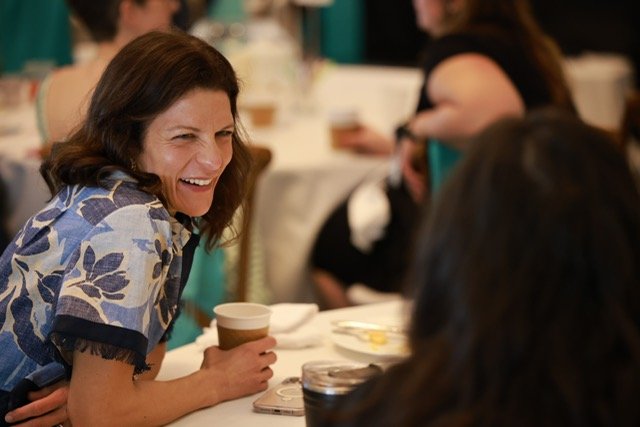You Deserve to Feel Confident Talking About Nutrition
If you’ve ever felt uneasy giving nutrition advice—or frustrated that you didn’t have better answers when a patient asked you about macros, sugar, or supplements—please know this:
You are not alone. And it’s not your fault.
As physicians, we’ve been trained to save lives, solve complex problems, and respond to emergencies. But when it comes to nutrition? Most of us received barely a few hours of education. No roadmap. No practical tools. And certainly no guidance on how to confidently apply it in the clinic.
Meanwhile, your patients are turning to social media, influencers, and Google—because they desperately want someone they trust to help them make sense of it all.
“My doctor referred me to a dietitian, but my insurance only covers six visits per year. I’ve struggled with my weight my entire life. How is that enough?”
“By the time I felt safe and understood by my dietitian… it was my last covered session. I cried in the parking lot.”
“Every time I see a new provider, I have to start from scratch. One told me to go keto. The next said absolutely not. I’m so tired of being confused.”
“I felt judged—not supported. I just wanted someone to help me figure out what works for me.”
“They told me to log my food and come back in six months. I needed help. Not a checklist.”
“Why is obesity treated like a temporary issue when it’s been part of my life for decades?”
“I’m doing my best. I’m already eating less fat, watching my carbs, trying to move more. I just want someone who understands the science and the struggle.”
These stories aren’t rare. They’re happening every day.
But here’s the beautiful part:
We can change this.
I Created This Program Because I Believe in You
Over the past eight years, I’ve worked closely with women physicians—brilliant, compassionate leaders—who wanted to take better care of themselves and empower their patients with more than just prescriptions.
Through that journey, I developed a practical, evidence-based, deeply supportive nutrition training program designed specifically for healthcare professionals.
One that respects your time. One that honors your expertise. One that fills in the gaps—without piling on more overwhelm.
And now, I’ve made it even better.
What’s Inside the Program?
✔️ 24 modules on topics you wish were covered in med school
✔️ Custom tools like protein charts, macro calculators, and meal planning guides
✔️ 14 Longevity & Healthspan modules (with exact scripts to use with your patients)
✔️ Monthly LIVE Q&A calls + replays, so you’re never left wondering what to say
✔️ Up to 48 CME credits, use up to 30 for Group Two credits for Obesity Medicine board certification
✔️ Done-for-you clinician handouts to use in real time
But more than anything?
This program gives you confidence.
It gives you language.
It gives you freedom from the doubt that creeps in when you know nutrition matters—but you weren’t trained to talk about it.
This Isn’t Just Another Course—It’s a Return to Why You Became a Doctor
I built this for you because I’ve been where you are.
Because I believe that when we nourish ourselves, we show up differently—for our patients, our families, and our purpose.
Because I’ve seen what happens when a physician is empowered to lead with both compassion and clarity—and I want that for you, too.
If you’ve been waiting for the right moment to invest in yourself and your practice… this is it.
Let’s change the way medicine does nutrition—together.














Why We Created Nutrition Training & Obesity Prevention Program for Healthcare Professionals
(aka Why You’re Going to Love Every Second of It)
PLUS: New Addition of Longevity & Healthspan Program
We created this program because it’s time for physicians to reclaim the real tools of healing—starting with nutrition and amplified by cutting-edge longevity science.
Here’s why this training isn’t just needed—it’s non-negotiable for anyone who wants to lead, heal, and thrive in modern medicine:
1. Because Nutrition in Med School Was Basically a Footnote
Doctors graduate knowing how to write prescriptions, but not how to rewrite health. This program fixes that. You’ll finally get the education your patients thought you already had.
2. Because You’re Done Watching Chronic Disease Run the Show
Obesity, diabetes, heart disease—they all start on the plate. Imagine if your impact didn’t start in the ER, but in the kitchen.
3. Because You Want to Drive Measurable Patient Outcomes
This isn’t about generic handouts. It’s about real-world coaching, weight loss that lasts, improved labs, fewer meds, and long-term lifestyle change.
4. Because Patients Are Asking for Your Help—and You Deserve to Feel Prepared
You’ll walk away ready to deliver actual, practical advice that your patients will trust—and follow.
5. Because When You Know Your Stuff, Patients Listen
Nutrition training builds your credibility. You’ll instantly become that physician who gets it, building stronger bonds and greater trust.
6. Because Prevention Saves More Than Just Lives
It saves time, energy, money, and system resources. And you get to be the physician who makes that happen.
7. Because Cookie-Cutter Doesn’t Work
You’ll learn how to personalize nutrition based on lifestyle, culture, age, and medical conditions. No guesswork. Just precision coaching.
8. Because You Want to Stay Ahead of the Curve
Nutrition science evolves fast. This program keeps you ahead of trends, fads, and false claims so you can confidently cut through the noise.
9. Because You’re Done Competing With Google
With your expertise, you’ll be the go-to source—no more fighting Dr. TikTok or Nurse Instagram.
10. Because Metabolic Health Is Everything
From insulin resistance to inflammation, nutrition is the gateway to reversing disease. You’ll learn how to use it powerfully and sustainably.
11. Because You Want to Work Smarter With Your Team
Better conversations with dietitians. Better integration in multidisciplinary care. This program makes you the ultimate collaborator.
12. Because This is What Patients Are Begging For
They want real nutrition support—and they want it from you.
13. Because You Deserve to Thrive Too
This program isn’t just about helping patients. It’s about giving you the tools to eat, feel, and function at your best—so you can keep doing the work you love.
14. Because Women’s Health Needs Nuance
You’ll get the tools to address everything from PCOS to perimenopause, with confidence and clarity.
15. Because You Actually Want to Move the Needle in Public Health
Nutrition is one of the most powerful ways to drive change at scale—and you’ll be part of that movement.
🌟 New: Our Longevity & Healthspan Curriculum
We didn’t stop at nutrition.
We added an entire Longevity & Healthspan series—designed for physicians who want to stay on the leading edge of wellness science and translate it into daily clinical impact.
From muscle preservation and metabolic flexibility, to brain health, cold exposure, gut microbiome, and stress resilience, our monthly modules help you:
Extend your patients’ healthspan, not just lifespan
Promote vitality, function, and independence well into aging
Support hormone balance, immune strength, and cognitive clarity
Understand how to apply modern longevity interventions across diverse populations
You’ll also get clinic-ready tools and CME-style quick references so you can implement what you learn immediately—without overwhelm.
This isn’t fringe science. This is the future of medicine—and you’ll be leading it.
16. Because You Deserve CME Credits That Actually Change How You Practice
We offer up to 48 AMA PRA Category 1 Credits™, fully ACCME-accredited, because your growth deserves recognition and reward.
17. Because It Counts Toward Obesity Medicine Board Certification
You can apply up to 30 Group Two credits toward your Obesity Medicine certification—moving you forward in your journey as a leader in prevention and metabolic care.




Why Choose Our Program?
Over the past eight years, I’ve had the privilege of walking alongside some of the most compassionate, hardworking women physicians—supporting them as they found their way back to themselves.
Together, we’ve done more than talk about nutrition or wellness. We’ve created space for transformation—starting with their own health and radiating outward into their practices, their patients, and their lives.
These women didn’t just learn how to eat better or feel better (though they absolutely did). They became confident leaders in a new kind of medicine—one that honors science and humanity, evidence and empathy.
What’s been most meaningful to me is watching how, once they reclaimed their energy and vitality, they couldn’t help but share it. They began bringing personalized, practical nutrition into every patient conversation—creating ripples of change that still give me goosebumps.
This program is a reflection of that journey.
It’s built from real stories, real science, and real hope. And it’s here to support you, just like it supported them.
If you’ve been craving a way to reconnect with your passion, feel strong in your body, and show up for your patients in a deeper way… this is your invitation.
We’ll take this step together. And I promise—it will be worth it.
This Program Might Sound Too Good to Be True… But It’s Very Real—and It’s Here for You.
If you’ve ever wished for a nutrition program that speaks directly to the realities of clinical practice and transforms the way you care for yourself and your patients... this is it.
We didn’t just build another educational course. We built your new favorite clinical tool. Your mindset shift. Your personal breakthrough. Your edge in medicine.
A Curriculum That Actually Feels Like a Game-Changer
You’ll dive into 24 high-impact modules covering everything from motivational interviewing to decoding metabolic health. Learn to calculate BMR and TDEE, assign macros, read body types, and guide sustainable transformation with confidence.
And yes—you’ll get the actual tools:
✅ Custom protein charts for men & women based on goal
✅ Provider PDF Nutrition Guide to walk your patients from start to finish
✅ Nutrition Audit Workbook so that you can feel confident in your recommendation
✅ 12 months of access so that you have plenty of time to use the materials
✅ CME credit
But here’s where it gets even better...
🌿 Now Featuring: 14 Longevity & Healthspan Modules + Clinician Guides
We’ve just added a brand-new, evidence-based Longevity Curriculum that will blow you away.
Think: Cellular repair. Metabolic flexibility. Gut health. Hormone optimization. Cold therapy. Brain health. Social connection.
Each of the 14 longevity topics comes with a concise, clinic-ready Clinician Guide—including the exact patient language you can use to communicate these cutting-edge insights with clarity, confidence, and ease.
You don’t have to decode the research or “translate” the science—we give you the words, the strategy, and the credibility.
You’ll look like a genius—and feel like one too.
Monthly Live Q&A + Access to Replay Vault
Join me live each month to get your questions answered—or catch the replays on your own time. These sessions are packed with clarity, compassion, and clinical pearls that you won’t want to miss.
CME + Career Elevation
You’ll earn up to 48 AMA PRA Category 1 Credits™ AND get access to 30 Group Two CME credits that count toward Obesity Medicine Board Certification.
No extra steps. No fine print. Just a real path toward board advancement and deeper professional impact.
Real Tools. Real Change. Real Confidence.
When you finish this program, you won’t just know more. You’ll practice differently.
You’ll connect more deeply.
You’ll feel better in your own body.
You’ll create breakthroughs—for yourself and your patients.
Because that’s what happens when education meets mentorship meets strategy.
🏃♀️ Bonus: The FIT Collective® Workout Samples
Get a behind-the-scenes look at our 10-minute workout philosophy—designed for real life, real results, and busy professionals like you. These efficient, approachable workouts are a client favorite—and now, they’re yours to try.
Use them to boost your own strength and energy, and learn how we help clients build confidence and muscle with ease.
🩺 Built by a Physician, for Physicians
This program is infused with over two decades of hands-on experience—and eight years of working directly with women physicians to reclaim their health, refine their practices, and reconnect to purpose.
You don’t need to do more. You just need the right support, and the right tools. And that’s exactly what this is.
Ready to feel better, practice better, and live better?
This is your moment.
Join us—and let’s change the way medicine does nutrition, longevity, and well-being... for good.
EXPERT DELIVERY WITH 12-FEATURES
AS SOON AS YOU JOIN, YOU GET ACCESS TO:
24 Learning Nutrition Training Modules
NEW FEATURE 14 Module, Evidence Based Longevity Program
Live Monthly Q&A with ability to submit questions ahead of time
Past Q&A replay library
Emotional Eating Training Program
Optimal Body Composition Training Program
Provider’s Nutrition Handbook PDF
Nutrition Audit Guide PDF
The Fit Collective’s Protein Charts PDF
The Fit Collective’s Mindful Macros Recipe Book PDF
31-Days of FIT
Beginner Strength Training 4-Week Sample Program
Advanced Strength Training 4-Week Sample Program
Claim 48 AMA PRA Category 1 Credits™. Obtain 30 CME Credits Towards Obesity Medicine Board Certification.
READ ABOUT ELIGIBILITY REQUIREMENTS HERE. Applicants may complete up to 30 GROUP TWO CME credits. GROUP TWO credits include any AMA PRA Category 1 Credit™ from sponsors other than those designated as ABOM’s Primary Obesity Medicine CME partners. GROUP TWO credits must include the word “obesity” in the course title. Please note: GROUP TWO credits are available as an option for those applicants who wish to earn credits from course sponsors outside of the Primary Obesity Medicine CME partners.
Access Length:
Content Access & Live Monthly Calls for 12-Months
Investment:
One time payment of $1,597




Nice to Meet You!
Hi, I’m Dr. Ali Novitsky, a triple board-certified physician in obesity medicine, pediatrics, and neonatology, and the founder of The FIT Collective®, where I’ve spent the past eight years working with women physicians to optimize their health.
As a seasoned nutrition and exercise strategist specializing in metabolic health, I’ve helped countless healthcare professionals transform their own lives — and, in turn, bring these principles to their patients.
Many of these physicians have been informally incorporating my strategies into their practices for years, and they’ve asked me time and again to create an official training program. That’s why I developed The Nutrition Training Program, a course designed to give healthcare professionals the tools, confidence, and science-backed strategies to provide impactful nutrition counseling, even with limited time during patient visits.
My passion for this work is deeply personal. My own health journey began at six years old, navigating the challenges of weight, body image, and diet culture. After breaking free from restrictive cycles, shedding 60 pounds, and maintaining my progress for over 22 years, I understand the emotional and physical hurdles many face. This experience, combined with my medical expertise, drives my commitment to empowering others with simple, sustainable, and effective approaches to health.
Through this program, I teach you how to seamlessly integrate nutrition counseling into your practice without adding extra stress to your packed schedule. Whether your goal is to guide patients through sustainable weight loss, improve metabolic health, or foster long-term wellness, I’ll show you how to make every interaction count.
As a former Division 1 athlete and a physician specializing in obesity medicine, I combine real-world strategies with evidence-based science to create a comprehensive, actionable framework. My approach prioritizes breaking free from diet culture, honoring the authentic self, and embracing sustainable habits that foster both confidence and joy.
In my Nutrition Training Program, we’ll bridge the gap between science and real-life application, empowering you to elevate your practice while helping your patients thrive.
Nutrition That Doctors Recommend to Their Patients
-

Dr. Sara Ayers, Pediatrics & Obesity Medicine
"As a pediatrician and obesity medicine physician, I was thrilled that Dr. Ali's program includes modules specifically focused on working with kids. Her relatable, down-to-earth style and engaging videos make learning not only enjoyable but incredibly impactful. The principles she teaches are effective, practical, and designed to empower both providers and patients without feeling overwhelming. If you're working in healthcare, this program is an absolute must—it’s a game-changer for delivering compassionate, results-driven care."
-

Dr. Matthea Rentea, Obesity Medicine
“I have been able to include Dr. Alis simple approach and get increased results with my patients. They really understand very quickly what’s important. This was hard for me to stress before in quick visits. I was also asking them to do too many things and they would be overwhelmed. I really recommend Ali’s approach for clinicians that want to help their patients in a quick, strategic, efficient way. “
-

Dr. Daisy Estrada, Family & Obesity Medicine
“As a busy primary care physician, I find myself trying to educate my patients on how to improve their nutrition to avoid and/or improve chronic medical problems. Dr. Ali Novitsky’s nutritional training has helped me address this efficiently during the short clinical encounter. I am able to provide them an individualized nutritional approach to created sustainable changes without overwhelming the patient with too many changes. The results have been incredible. I also have benefited from the nutritional training personally. I recommend Dr. Ali Novitsky’s nutritional training to all clinicians who want to address an important pillar in their patients health journey.”
-

Dr. Mark Novitsky, Psychiatry & Obesity Medicine
“I cannot stress enough the value of Dr. Ali Novitsky's nutrition training. Her program addresses the vital gaps that medical training often leaves unexamined, providing not just foundational knowledge applicable to all patients, but also the nuanced understanding necessary for individualized care. It has not only transformed my ability to manage my patients effectively but has been instrumental in helping me optimize my own health”
-

Dr. Katie Jobbins, Internal Medicine & Obesity Medicine
“Dr Ali’s approach to health not only includes the physical aspect but how best to approach what we use to fuel our bodies. Her approach with nutrition is the training many of doctor’s wish we had received in medical school and allows us to level what we can offer to patients “
-

Dr. Ali Miles, Pediatrics & Cardiac Critical Care
“Dr. Ali’s simple, health-focused programs have been game-changing for me. So many of us grew up and were trained with the shortsighted and weight-focused philosophy of “eat less, move more.” I am now able to take what I have learned back to my patients and counsel them efficiently and effectively in a way that prioritizes long term, sustainable wellness. “
Dr. Laura Demoya
"This program was truly exceptional for me, providing not only fresh, insightful content but also a wealth of medical knowledge that was presented in a simple, practical way anyone can understand and apply to their daily life. I especially appreciated how it debunked common nutrition and diet myths, offering a refreshing perspective."
Julie Metelski
“I just completed the coursework for the Nutrition Training Program and wanted to dropa note. I am a 66-year-old semi-retired IT project manager. I have struggled for my entire life with being overweight and all the issues that came along with that. I have been on diets from Weight Watchers onward, taking weight loss drugs (pills) long before the GLP-1s came to market, and having had 2 Gastric bypass surgeries in the 1990s. I am not a medical professional, so my interest in this course was personal. After finally succeeding in getting to a ’normal’ weight at this point in my life, maintenance is my challenge. The information provided in this course has given me the tools and confidence that I can conquer my maintenance goals. Thank you, Ali, for opening your program to non-medical professionals to participate, I've not seen this opportunity elsewhere. “
Dr. M
“Enrolling in Dr. Ali Novitsky’s nutrition program has been an invaluable experience. Through her teachings, I’ve gained more insight into nutrition, exercise, and obesity medicine than I ever did from other CME courses or exam preparation alone. I’m thrilled to have passed the ABOM exam and incredibly grateful for Ali’s guidance and expertise.”
Dr. Komal Patil-Sisodia
"As an endocrinologist, obesity medicine physician, and menopause expert, I can confidently say that Dr. Ali's nutrition training is 100% on point. For the past six years, I’ve been using her principles to guide my patients toward optimal metabolic health, and the results have been extraordinary. This training is uniquely focused on achieving sustainable, evidence-based outcomes, and there’s truly nothing else like it out there. It’s a game-changer for anyone serious about advancing their expertise in metabolic health and obesity medicine."
Dr. Diana Pallin
"As an obesity medicine doctor with 10 years of experience in the field, Dr. Ali Novitsky's nutrition training program has been transformative. It provided me with the most up-to-date principles to help my patients achieve their best results. What sets this program apart is its robust and innovative approach, incorporating a creativity component that inspires both patients and providers to take meaningful action. I feel excited, confident, and deeply grateful knowing that I am bringing the very best to my patients."
Dr. Bridget Godwin
"Completing Dr. Ali’s Nutrition Training program has been a game-changer. As a pediatric gastroenterologist with an interest in nutrition and integrative medicine, her principles rounded out my knowledge, filling in the piece of the pie focused on how a balanced diet can positively impact metabolic health. Her training includes multiple ways to offer nutrition plans, allowing for extremely personalized recommendations. She also includes a beautiful and gentle way to speak to adolescents about their health, always being thoughtful and careful to avoid bringing diet culture into the conversation. I am deeply honored to join Dr. Ali’s team in Transform where I can help others learn these life-changing principles."
Dr. Ashley Sandeen
"Dr. Ali's nutrition training program is so comprehensive that it leaves absolutely nothing uncovered. The principles she teaches are practical, effective, and life-changing—I use them for myself, my family, and my clients with remarkable success. This program is a must for anyone serious about making a difference in addressing obesity rates in our country. It's a resource that empowers healthcare professionals and individuals alike to drive meaningful change and improve lives."
Christina Moore
"I am not a doctor, but I truly appreciate this course. It’s inspiring to see training aimed at changing the status quo for both doctors and trainers. The section on motivational interviewing was especially impactful—I hope all doctors take a course like this to learn how to create a safe and supportive environment for their patients. I’ve gained so much insight, not only about what I can work on in my own life but also in how I show up as a patient.”














What You Will Learn
Week 1
Motivational Interviewing: Understand your patient’s readiness and obstacles.
Gathering Data: Properly use InBody scales for initial measurements and tracking progress.
Week 2
Assessing Body Type: Tailor your approach to individual needs.
Nutrition Audit: Understand the “how”s and “why”s.
Week 3
Interpreting Nutrition Audits: Draw actionable insights.
BMR & Hunger Hormones: Calculate and apply effectively.
Week 4
Setting Goals: Align strategies with realistic outcomes.
Nutrition for Fat Loss vs. Muscle Gain: Differentiate approaches.
Week 5
Choosing Nutrition Strategies: From intuitive eating to calculated macros.
Calculating Macros: Start and adjust with precision.
Week 6
Mindful Macros: Identify ideal starting points.
Intuitive Eating: Promote sustainable habits.
Week 7
Nutrition: Putting it all together.
Tracking Progress: Use InBody reviews for mental, emotional, and physical goals.
Week 8
Exercise Strategy: Overcome diet culture with goal-based routines.
Handling Plateaus: How we view them as opportunities for growth.
Week 9
Mindset Barriers: Tackle common thought distortions.
GLP-1 Medications: Ensure muscle maintenance with our strategic approach.
Week 10
4 Pillar Obesity Medicine: Integrate exercise, nutrition, mindset, and medications.
Post Bariatric Surgery Nutrition: Learn Our Approach to helping our surgical patients with optimal nutrition including macro considerations.
Week 11
Nutrition Considerations on GLP-1 Medications: Approach when patients have lost muscle mass or are at risk of losing muscle mass based on In body trends.
Keeping Kids Out of Diet Culture: This topic focuses on promoting healthy eating habits and body positivity in children while steering them away from restrictive or harmful dieting practices.
Week 12
Simple Beginner Nutrition Strategy for Kids: A practical approach to helping children develop healthy eating habits.
Evaluating Muscle Mass Percentages in Adults: This topic explores how to assess muscle mass percentages in adults using tools like InBody scans and other body composition analyses.
NEW FEATURE: Longevity Series with Ali Novitsky, MD
Part of Your Nutrition Training & Obesity Prevention Program if enrolled on or after August 1st, 2025.
Optimize Patient Outcomes with the Latest in Longevity Science
The Evidence-Based Longevity and Healthspan Series is now a featured component of your Nutrition Training Program. Designed by board certified obesity medicine physician and master certified coach Dr. Ali Novitsky, this 14-session series gives you the tools to translate emerging science into real-world clinical strategies that improve both lifespan and healthspan.
What’s Included:
14 Expert-Curated Sessions grounded in cutting-edge research
Strategies that align nutrition, movement, mindset, and recovery to longevity outcomes
Direct application to diverse patient populations, including midlife and metabolically at-risk individuals
Full Curriculum:
Nutrition for Cellular Repair – Support autophagy, mitochondrial healing, and nutrient signaling
Strength Training for Muscle Preservation – Build and preserve lean mass to reduce mortality risk
Metabolic Flexibility – Enhance fuel switching, insulin sensitivity, and mitochondrial efficiency
Sleep & Circadian Rhythm – Restore hormonal and cellular repair cycles through sleep science
Stress Adaptation & Resilience – Reduce allostatic load and train the nervous system
Cardiovascular Conditioning – Improve VO₂ max and endothelial health as biomarkers of healthspan
Hormone Optimization – Support estrogen, testosterone, cortisol, and insulin balance
Gut Microbiome & Inflammation – Promote microbial diversity to reduce systemic aging
Purpose, Identity & Mental Fitness – Cultivate meaning, motivation, and brain longevity
Body Composition & Visceral Fat – Shift the muscle-to-fat ratio for metabolic protection
Environmental & Toxin Exposure – Minimize endocrine disruptors and support detoxification
Social Health & Connection – Leverage the biological impact of safe, supportive relationships
Brain Health & Neuroprotection – Use lifestyle tools to slow cognitive aging and support neuroplasticity
Cold & Heat Therapy for Longevity – Harness thermal stress to boost resilience and cellular repair
Why This Matters:
This series integrates the science of aging with practical, sustainable tools you can apply immediately. You’ll walk away with:
A deep understanding of the physiological drivers of aging
Actionable protocols to help patients build habits that last
Confidence to lead with the most current strategies in preventative and longevity medicine
Exclusive Guides and Content
Emotional Eating Training Program
A deep dive into the psychology of food, this training helps providers understand the emotional drivers behind eating behaviors—stress, boredom, guilt, reward, and more.
You’ll learn how to spot patterns, guide compassionate conversations, and introduce realistic tools that support healing, not restriction. This isn’t about willpower—it’s about awareness, regulation, and transformation.
Ideal for providers who want to coach lasting change in emotional and stress-related eating.
Optimal Body Composition Training Program
This program goes beyond weight loss. You’ll learn the science behind preserving lean muscle, reducing visceral fat, and achieving metabolic health through nutrition and movement.
It includes key strategies for protein intake, resistance training, and InBody or body comp interpretation—designed to help you and your patients maintain strength, performance, and longevity.
Perfect for clinicians supporting patients on GLP-1 medications or those navigating rapid weight loss.
The FIT Collective Provider's Nutritional Guide
Your go-to reference for day-to-day clinical use. This guide breaks down complex nutrition topics into simple, science-backed explanations that are easy to share with patients.
You’ll find recommendations on macronutrients, hydration, meal timing, sugar reduction, and more—plus tips on how to speak to patients at different readiness stages.
It’s like having your own nutrition consultant in your back pocket.
The FIT Collective Provider’s Longevity & Healthspan Guide
This companion guide to the Longevity & Healthspan modules gives you the exact language and talking points to use with patients—whether you’re discussing circadian rhythm, cold therapy, metabolic flexibility, or stress adaptation.
Each section summarizes the latest research and connects it to real-life, personalized strategies.
Designed to help you bring longevity science into everyday care—without sounding like a textbook.
The FIT Collective Nutrition Audit Workbook
A hands-on tool that guides providers (and their patients) through a reflective nutrition self-assessment.
Use it to uncover current eating patterns, energy fluctuations, mindset triggers, and nutrient gaps.
This workbook helps shift the conversation from judgment to curiosity—and creates space for growth.
Great for intake sessions, coaching programs, or personal use.
The FIT Collective Custom Protein Charts
Simple, visual, and effective—these charts make it easy to assign appropriate protein targets based on activity level, age, and health goals.
You’ll also get examples of high-protein foods, sorted by plant and animal sources, so patients can build balanced meals with clarity and confidence.
Excellent for macro counseling, muscle-building programs, and weight loss support.
Mindful Macros® Recipe Book
Nutrition guidance meets real-life cravings in this delicious collection of balanced, macro-friendly recipes.
Each dish is designed with mindful eating principles and portion guidance in mind—making it easy for patients to eat well without feeling deprived.
31 Days of FIT Exercise Program
A no-excuses, high-impact program designed to build momentum, strength, and confidence—one day at a time. This 31-day experience features daily workouts that are short, effective, and completely doable, even on the busiest schedule.
Each session focuses on functional fitness, muscle engagement, and consistency over perfection. Whether you're just getting started or getting back on track, this program is your jumpstart to sustainable movement.
Perfect for clients and clinicians looking for a reset or a re-commitment to movement in under 11 minutes a day.
Beginner Strength Sample Program
A sneak peek into our signature strength training program that fuses physical fitness with emotional empowerment. This sample delivers 10-minute strength workouts paired with mindset cues designed to promote resilience, confidence, and body-awareness.
It's not just about muscle—it’s about mental stamina, self-trust, and showing up for yourself.
Ideal for anyone exploring how strength training can improve not only physique—but purpose, energy, and self-image.
Advanced Strength Training Sample Program
Ready to level up? This sample program is for those who already have a fitness foundation and are looking to build serious strength, stability, and lean mass.
It introduces progressive overload techniques, split training strategies, and muscle-specific programming—designed to push past plateaus and support long-term gains.
Built for high performers, this is strength training with intention, progression, and measurable results.



Program Investment
Let's Do This!
Don't miss this unique opportunity to revolutionize your approach to patient care. Sign up today to secure your spot and start your journey toward becoming a leader in nutrition.
By joining the Nutrition Training Program for Healthcare Professionals, you are making a commitment to excellence in patient care and professional growth. We look forward to welcoming you and seeing the impact you’ll make!
CME Outline
Target Audience: Healthcare providers involved in obesity medicine, nutrition, and patient care.
Total Credits: 48 AMA Category 1 Continuing Medical Education Credits.
Use 30 CME Credits Towards Obesity Medicine Board Certification.
READ ABOUT ELIGIBILITY REQUIREMENTS HERE. Applicants may complete up to 30 GROUP TWO CME credits. GROUP TWO credits include any AMA PRA Category 1 Credit™ from sponsors other than those designated as ABOM’s Primary Obesity Medicine CME partners. GROUP TWO credits must include the word “obesity” in the course title. Please note: GROUP TWO credits are available as an option for those applicants who wish to earn credits from course sponsors outside of the Primary Obesity Medicine CME partners.
Week 1
Motivational Interviewing
Practice Gap: Clinicians often lack structured methods to assess and address patient ambivalence in lifestyle change.
Objectives:
Identify stages of readiness for change in patients.
Apply open-ended questions and reflective listening techniques.
Use motivational interviewing to uncover and address obstacles to adherence.
References:
Miller WR, Rollnick S. Motivational Interviewing: Helping People Change. 3rd ed. Guilford Press; 2013.
Resnicow K, et al. Motivational interviewing in health promotion. Am J Prev Med. 2002;23(1 Suppl):68–74.
Gathering Data with InBody
Practice Gap: Providers may not be utilizing InBody metrics effectively to guide clinical decisions.
Objectives:
Interpret key metrics from InBody scans.
Use InBody data to establish a patient baseline.
Implement routine tracking to assess longitudinal progress.
References:
Kyle UG, et al. Bioelectrical impedance analysis—Part II. Clin Nutr. 2004;23(6):1430–53.
Moon JR. Body composition in athletes and sports nutrition. Curr Sports Med Rep. 2013;12(4):201–7.
Week 2
Assessing Body Type
Practice Gap: Personalized recommendations based on somatotype are underutilized in clinical nutrition.
Objectives:
Classify patients by primary body type.
Adjust recommendations based on body type.
Anticipate typical challenges by body type.
References:
Heath BH, Carter JEL. A modified somatotype method. Am J Phys Anthropol. 1967;27(1):57–74.
Norton K, Olds T. Anthropometrica. UNSW Press; 1996.
Nutrition Audit
Practice Gap: Providers fail to systematically evaluate patients' nutrition habits.
Objectives:
Guide patients in accurate food logging.
Identify behavior patterns.
Recognize nutritional deficiencies or excesses.
References:
Academy of Nutrition and Dietetics. Nutrition Care Process Model. 2022.
Thompson FE, Subar AF. Dietary assessment methodology. In: Nutrition in the Prevention and Treatment of Disease. Elsevier; 2017.
Week 3
Interpreting Nutrition Audits
Practice Gap: Clinicians don’t draw actionable insights from food logs.
Objectives:
Analyze food audits.
Translate findings into strategy.
Provide personalized feedback.
References:
Kirkpatrick SI, et al. Dietary assessment in health research. Nutrients. 2018;10(8):884.
Foster GD, et al. Behavioral treatment of obesity. Am J Clin Nutr. 2005;82(1 Suppl):230S–235S.
BMR & Hunger Hormones
Practice Gap: Hormonal and BMR metrics are underused in treatment plans.
Objectives:
Calculate BMR.
Explain ghrelin/leptin roles.
Apply data to planning.
References:
Müller MJ, et al. Basic concepts for energy expenditure. Clin Nutr. 2004;23(6):1226–43.
Klok MD, et al. The role of leptin and ghrelin in obesity. Obes Rev. 2007;8(1):21–34.
Week 4
Setting Goals
Practice Gap: Patients often set unrealistic goals.
Objectives:
Define SMART goals.
Align goals with readiness.
Monitor and adapt.
References:
Locke EA, Latham GP. Building a practically useful theory of goal setting. Am Psychol. 2002;57(9):705–17.
Bodenheimer T, Handley MA. Goal-setting for behavior change. Patient Educ Couns. 2009;76(3):319–25.
Fat Loss vs. Muscle Gain Nutrition
Practice Gap: Differentiated strategies are rarely taught.
Objectives:
Contrast caloric/macronutrient needs.
Educate patients accordingly.
Use data to revise targets.
References:
Helms ER, et al. Evidence-based recommendations for natural bodybuilding. J Int Soc Sports Nutr. 2014;11(1):20.
Thomas DT, et al. Position of the Academy of Nutrition and Dietetics on Nutrition and Athletic Performance. J Acad Nutr Diet. 2016;116(3):501–28.
Week 5
Choosing Nutrition Strategies
Practice Gap: Nutrition plans often mismatch patient lifestyle.
Objectives:
Compare various strategies.
Match based on personality.
Transition as needed.
References:
Tylka TL, Kroon Van Diest AM. Intuitive eating framework. Eat Disord. 2013;21(3):195–208.
MacLean PS, et al. Biological control of appetite. Obesity. 2015;23(8):1529–39.
Calculating Macros
Practice Gap: Estimations replace precise planning.
Objectives:
Use BMR and activity for calculations.
Adjust with feedback.
Include patient preferences.
References:
Mifflin MD, et al. A new predictive equation for resting energy expenditure. Am J Clin Nutr. 1990;51(2):241–7.
Hall KD, et al. Energy balance and obesity. Lancet Diabetes Endocrinol. 2017;5(12):873–82.
Week 6
Mindful Macros
Practice Gap: Macro tracking can trigger rigidity.
Objectives:
Integrate mindfulness with macros.
Identify disordered behavior.
Customize ranges.
References:
Kristeller JL, Wolever RQ. Mindfulness-based eating awareness. J Eat Disord. 2014;2(1):31.
Segal ZV, et al. Mindfulness-Based Cognitive Therapy for Depression. Guilford Press; 2013.
Intuitive Eating
Practice Gap: Not well integrated in clinical practice.
Objectives:
Define principles.
Integrate cues with goals.
Avoid restrictive patterns.
References:
Tribole E, Resch E. Intuitive Eating. 4th ed. St. Martin’s Essentials; 2020.
Van Dyke N, Drinkwater EJ. Relationships between intuitive eating and health indicators. Public Health Nutr. 2014;17(8):1757–66.
Week 7
Putting It All Together
Practice Gap: Integration of strategies is inconsistent.
Objectives:
Synthesize learned content.
Create sustainable plans.
Use reflection for adjustment.
References:
Prochaska JO, DiClemente CC. Stages of change and health behaviors. Am J Health Promot. 1992;7(1):38–48.
Miller WR. Integrating Clinical Strategies. Guilford Press; 2013.
Tracking Progress
Practice Gap: Patients don’t tie data to personal meaning.
Objectives:
Review metrics with emotion context.
Reframe plateaus.
Combine objective and subjective data.
References:
Bland JM, Altman DG. Statistical methods for assessing agreement. Lancet. 1986;1(8476):307–10.
Andersen E, et al. Self-monitoring and weight loss. Obesity. 2008;16(12):2913–21.
Week 8
Exercise Strategy
Practice Gap: Routines reflect outdated or aesthetic goals.
Objectives:
Design goal-driven programs.
Focus on strength and function.
Deconstruct toxic fitness messaging.
References:
Garber CE, et al. Exercise guidelines. Med Sci Sports Exerc. 2011;43(7):1334–59.
Kravitz L. Exercise and body image. IDEA Fit. 2002.
Handling Plateaus
Practice Gap: Plateaus seen as failure.
Objectives:
Normalize physiological adaptation.
Identify causes.
Build resilience.
References:
Dulloo AG, et al. Adaptive thermogenesis. Am J Clin Nutr. 2015;102(4):804–11.
Foster GD, et al. Behavioral approaches to plateaus. J Am Diet Assoc. 1997;97(9):1041–7.
Week 9
Mindset Barriers
Practice Gap: Cognitive distortions limit progress.
Objectives:
Recognize thought patterns.
Apply CBT tools.
Link mindset to behavior.
References:
Beck JS. Cognitive Behavior Therapy: Basics and Beyond. Guilford Press; 2011.
Burns DD. Feeling Good: The New Mood Therapy. Harper; 1999.
GLP-1 Medications
Practice Gap: Muscle loss risk is not addressed.
Objectives:
Explain mechanism of GLP-1s.
Combine with resistance training.
Monitor InBody for muscle mass.
References:
Nauck MA, et al. GLP-1 physiology and pharmacology. Diabetes Obes Metab. 2004;6(6):402–14.
Wilding JPH, et al. Muscle preservation during weight loss. Obesity. 2021;29(1):124–133.
Week 10
4 Pillar Obesity Medicine
Practice Gap: Only one pillar often emphasized.
Objectives:
Describe all four pillars.
Integrate into a single plan.
Prioritize based on need.
References:
Garvey WT, et al. AACE/ACE obesity guidelines. Endocr Pract. 2016;22(Suppl 3):1–203.
Kushner RF, Ryan DH. The 4 pillars of obesity treatment. Obesity. 2014;22(S2):S17–S24.
Post-Bariatric Nutrition
Practice Gap: Long-term guidance is lacking.
Objectives:
Tailor macros post-surgery.
Prevent deficiencies.
Offer lifestyle reinforcement.
References:
Mechanick JI, et al. ASMBS guidelines. Surg Obes Relat Dis. 2013;9(2):159–91.
Heber D, et al. Nutritional management of bariatric surgery patients. Am J Clin Nutr. 2010;91(5):1320S–1325S.
Week 11
GLP-1 Nutrition Considerations
Practice Gap: Lean mass monitoring is neglected.
Objectives:
Interpret InBody changes.
Adjust protein and training.
Educate on retention strategies.
References:
Lean ME, et al. GLP-1 and muscle health. Lancet Diabetes Endocrinol. 2019;7(5):356–367.
Keeping Kids Out of Diet Culture
Practice Gap: Harmful messages still pervade pediatric nutrition.
Objectives:
Promote body positivity.
Avoid restrictive language.
Support caregiver modeling.
References:
Golden NH, et al. Preventing obesity and eating disorders. Pediatrics. 2016;138(3):e20161649.
Week 12
Beginner Nutrition for Kids
Practice Gap: Few age-appropriate nutrition models exist.
Objectives:
Introduce food groups simply.
Model balanced plates.
Reinforce positive mealtime habits.
References:
USDA. MyPlate for Kids.
Evaluating Muscle Mass in Adults
Practice Gap: Muscle composition isn’t tracked routinely.
Objectives:
Analyze InBody for muscle metrics.
Spot sarcopenia early.
Integrate data into exercise/nutrition.
References:
Cruz-Jentoft AJ, et al. Sarcopenia: revised consensus. Age Ageing. 2019;48(1):16–31.
Buckinx F, et al. Body composition and health. Clin Nutr. 2018;37(6 Pt A):2328–2343.Week 8: Catch Up
Longevity CME Program
1. Nutrition & Cellular Repair
Objectives:
Explain the biological mechanisms of autophagy and mitophagy.
Identify nutrients and interventions that enhance mitochondrial healing.
Apply lifestyle strategies that upregulate nutrient signaling pathways (e.g., AMPK, mTOR).
Practice Gap:
Clinicians often lack practical tools to assess and enhance cellular turnover and energy production in aging patients, particularly through non-pharmaceutical interventions.
References:
Madeo F, Zimmermann A, Maiuri MC, Kroemer G. Cell Metab. 2019;29(3):546–561. https://doi.org/10.1016/j.cmet.2019.01.006
Lopez-Otin C, Kroemer G. Nat Rev Mol Cell Biol. 2021;22(4):263–284. https://doi.org/10.1038/s41580-020-00327-9
2. Strength Training for Muscle Preservation
Objectives:
Describe the relationship between skeletal muscle mass and all-cause mortality.
Implement progressive resistance training tailored to age and comorbidities.
Counsel patients on protein timing and intake for hypertrophy support.
Practice Gap:
Many clinicians are not trained to prescribe strength training protocols or assess sarcopenia risk proactively in aging populations.
References:
Fragala MS et al. J Am Med Dir Assoc. 2019;20(1):124–135. https://doi.org/10.1016/j.jamda.2018.10.003
McLeod M et al. Nutrients. 2019;11(6):1257. https://doi.org/10.3390/nu11061257
3. Metabolic Flexibility
Objectives:
Define metabolic flexibility and its role in aging and chronic disease.
Recognize signs of impaired fuel switching in clinical practice.
Integrate nutritional strategies (e.g., fasting, low glycemic index) to enhance metabolic adaptability.
Practice Gap:
Metabolic inflexibility is underdiagnosed, and most clinicians are unfamiliar with lifestyle-based strategies to restore insulin sensitivity and mitochondrial function.
References:
Smith RL et al. Metabolites. 2020;10(6):236. https://doi.org/10.3390/metabo10060236
Muoio DM. Cell Metab. 2021;33(2):214–231. https://doi.org/10.1016/j.cmet.2021.01.011
4. Sleep & Circadian Rhythm
Objectives:
Explain the effects of circadian disruption on hormone balance and cellular repair.
Identify key biomarkers of sleep quality and circadian health.
Counsel patients on light exposure, sleep timing, and chrononutrition.
Practice Gap:
Sleep is often overlooked in preventive medicine, and few providers incorporate circadian rhythm optimization into routine care.
References:
Walker WH et al. Nat Rev Endocrinol. 2020;16(4):213–225. https://doi.org/10.1038/s41574-019-0310-1
Manoogian ENC, Panda S. Nat Rev Endocrinol. 2017;13(7):427–439. https://doi.org/10.1038/nrendo.2017.56
5. Stress Adaptation & Resilience
Objectives:
Describe the physiological impact of chronic stress and allostatic load.
Integrate nervous system training techniques (e.g., breathwork, HRV biofeedback).
Recognize signs of stress-induced metabolic or immune dysregulation.
Practice Gap:
While stress is ubiquitous in patient populations, few providers are equipped with somatic and behavioral tools to build resilience.
References:
McEwen BS, Akil H. Neuropsychopharmacology. 2020;45(1):105–129. https://doi.org/10.1038/s41386-019-0441-9
Thayer JF, Lane RD. Biol Psychol. 2019;148:107–116. https://doi.org/10.1016/j.biopsycho.2019.06.009
6. Cardiovascular Conditioning
Objectives:
Identify VO₂ max as a key predictor of longevity.
Prescribe zone 2 and HIIT training to improve mitochondrial and endothelial health.
Assess cardiovascular fitness with practical, in-clinic tools.
Practice Gap:
Fitness biomarkers such as VO₂ max and endothelial function are rarely incorporated into routine evaluations or treatment plans.
References:
Ross R et al. Prog Cardiovasc Dis. 2019;62(1):54–67. https://doi.org/10.1016/j.pcad.2019.01.007
Santos-Parker JR et al. J Physiol. 2019;597(6):1685–1700. https://doi.org/10.1113/JP277300
7. Hormone Optimization
Objectives:
Review normal aging trajectories for sex and metabolic hormones.
Evaluate hormone panels and signs of dysregulation (e.g., insulin resistance).
Implement lifestyle changes that support endocrine balance.
Practice Gap:
Hormone decline is frequently dismissed as “normal aging” without considering safe optimization strategies or patient quality of life.
References:
Taylor AE et al. Lancet Diabetes Endocrinol. 2019;7(7):628–636. https://doi.org/10.1016/S2213-8587(19)30074-9
Santoro N et al. J Clin Endocrinol Metab. 2021;106(4):e1747–e1759. https://doi.org/10.1210/clinem/dgaa972
8. Gut Microbiome & Inflammation
Objectives:
Explain the gut-immune-longevity axis and its clinical implications.
Identify patterns of dysbiosis and common contributing factors.
Recommend nutrition and prebiotic/probiotic interventions.
Practice Gap:
Clinicians often lack clear clinical protocols for assessing or treating gut inflammation as it relates to aging and chronic disease.
References:
Wilmanski T et al. Nat Metab. 2021;3(2):274–286. https://doi.org/10.1038/s42255-021-00348-0
Vemuri R et al. Nutrients. 2018;10(10):1488. https://doi.org/10.3390/nu10101488
9. Purpose, Identity & Mental Fitness
Objectives:
Define purpose and identity as modifiable healthspan determinants.
Introduce tools to assess psychological flexibility and life satisfaction.
Guide patients in cultivating meaningful engagement and mental fitness habits.
Practice Gap:
Mental health is often siloed from physiological care, and tools for fostering purpose-driven health behaviors are rarely used.
References:
Boyle PA et al. JAMA Psychiatry. 2019;76(5):426–434. https://doi.org/10.1001/jamapsychiatry.2018.4746
Ryff CD. Psychother Psychosom. 2018;87(5):261–273. https://doi.org/10.1159/000488998
10. Body Composition & Visceral Fat
Objectives:
Explain the impact of visceral fat on metabolic and cardiovascular risk.
Interpret DEXA or InBody results in clinical decision-making.
Prescribe lifestyle strategies to shift the lean mass to fat ratio.
Practice Gap:
Body weight remains overemphasized, while muscle-to-fat ratios and visceral fat assessments are underutilized in clinical contexts.
References:
Neeland IJ et al. Circulation. 2019;139(7):837–849. https://doi.org/10.1161/CIRCULATIONAHA.118.031534
Kyle UG et al. Clin Nutr. 2022;41(4):818–825. https://doi.org/10.1016/j.clnu.2021.12.008
11. Environmental & Toxin Exposure
Objectives:
Identify common environmental toxins that impair metabolic and hormonal function.
Counsel patients on reducing exposures to plastics, pesticides, and endocrine disruptors.
Recommend strategies to enhance biotransformation and detoxification.
Practice Gap:
Environmental exposures are often omitted from clinical evaluations despite evidence linking them to chronic disease.
References:
Heindel JJ et al. Environ Health Perspect. 2017;125(9):A206–A209. https://doi.org/10.1289/EHP644
Kim MJ et al. Environ Int. 2020;134:105225. https://doi.org/10.1016/j.envint.2019.105225
12. Social Health & Connection
Objectives:
Describe the biological mechanisms by which social connection impacts longevity.
Screen for social isolation and relationship strain.
Prescribe strategies to enhance social support and community.
Practice Gap:
Social health is rarely addressed systematically in medical care despite being a strong predictor of morbidity and mortality.
References:
Holt-Lunstad J. Am Psychol. 2021;76(3):294–306. https://doi.org/10.1037/amp0000703
Haslam C et al. BMJ Open. 2018;8(3):e020313. https://doi.org/10.1136/bmjopen-2017-020313
13. Brain Health & Neuroprotection
Objectives:
Identify modifiable risk factors for cognitive decline.
Apply lifestyle interventions to promote neuroplasticity.
Use early screening tools for executive function and memory.
Practice Gap:
Neuroprotection is reactive rather than preventive in many clinical settings, missing key opportunities for early intervention.
References:
Livingston G et al. Lancet. 2020;396(10248):413–446. https://doi.org/10.1016/S0140-6736(20)30367-6
Erickson KI et al. Neurobiol Aging. 2019;83:140–147. https://doi.org/10.1016/j.neurobiolaging.2019.03.005
14. Cold & Heat Therapy for Longevity
Objectives:
Explain the physiological effects of hormetic stress via cold and heat exposure.
Evaluate evidence for saunas, ice baths, and contrast therapy.
Design safe protocols for thermal exposure based on patient health status.
Practice Gap:
Providers are unfamiliar with evidence-based applications of thermal therapies and how to integrate them into longevity plans.
References:
Laukkanen JA et al. Ann Med. 2019;51(1):47–55. https://doi.org/10.1080/07853890.2019.1605610
Tipton MJ. Exp Physiol. 2023;108(3):259–268. https://doi.org/10.1113/EP091429
Bonus Session
Session Topic: Emotional Eating & Body Composition Training Series
Practice Gap: Many clinicians and patients fail to connect emotional eating patterns with long-term body composition changes, leading to ineffective interventions and weight cycling.
Objectives:
Identify emotional eating triggers and differentiate them from physiological hunger cues.
Implement evidence-based strategies such as journaling, mindfulness, and coping techniques to reduce emotional eating.
Align emotional eating awareness with body composition goals using tools like InBody trends and behavior reflection.
Reference:
Sattelmayer GS, et al. (2017). The impact of emotional eating on weight loss. International Journal of Obesity, 41(5), 735–741.
Additional References
🔹 Behavior Change & Motivation
Rubak, S., Sandbæk, A., Lauritzen, T., & Christensen, B. (2005). Motivational interviewing: a systematic review and meta-analysis. Patient Education and Counseling, 60(1), 25–36.
Locke, E.A., & Latham, G.P. (2002). Building a practically useful theory of goal setting and task motivation: A 35-year odyssey. American Psychologist, 57(9), 705–717.
Beck, A. T. (2011). Cognitive therapy: Basics and beyond. New York: Guilford Press.
Prochaska, J.O., & DiClemente, C.C. (1983). Stages and processes of self-change of smoking: Toward an integrative model of change. Journal of Consulting and Clinical Psychology, 51(3), 390–395.
Bandura, A. (2004). Health promotion by social cognitive means. Health Education & Behavior, 31(2), 143–164.
🔹 Nutrition & Eating Behavior
Drewnowski, A., & Almiron-Roig, E. (2010). Human perceptions and preferences for fat and sugar. In: The Oxford Handbook of Food Politics and Society.
Iwao, K., et al. (2001). Reliable and accurate measurement of dietary intake: a comparative study of methods. American Journal of Clinical Nutrition, 73(3), 531–536.
Satter, E. (2007). Eating competence: nutrition education with the Satter Eating Competence Model. Journal of Nutrition Education and Behavior, 39(5 Suppl), S189–S194.
Rolls, B. J. (2009). The relationship between dietary energy density and energy intake. Physiology & Behavior, 97(5), 609–615.
Wadden, T. A., et al. (2012). Lifestyle modification for obesity: new developments in diet, physical activity, and behavior therapy. Circulation, 125(9), 1157–1170.
🔹 Exercise & Physical Activity
Scully, D., et al. (2018). Interventions to increase physical activity among young people: a systematic review. British Journal of Sports Medicine, 52(10), 681–686.
Helms, E.R., et al. (2014). Evidence-based recommendations for natural bodybuilding contest preparation: nutrition and supplementation. Journal of Sports Sciences, 32(17), 1571–1580.
Donnelly, J. E., et al. (2009). Appropriate physical activity intervention strategies for weight loss and prevention of weight regain for adults. Medicine & Science in Sports & Exercise, 41(2), 459–471.
🔹 Body Composition & Assessment
Nevill, A.M., & Holder, R.L. (2007). The role of bioelectrical impedance in body composition analysis. Sports Medicine, 37(8), 615–628.
Coyle, C., & Sayer, A.A. (2016). Body composition in the assessment of the health status of older adults. Nutrients, 8(8), 482.
Heymsfield, S. B., et al. (2015). Body composition assessment: advances in technology and translation to clinical practice. European Journal of Clinical Nutrition, 69(11), 1264–1270.
🔹 Emotional, Social, and Long-Term Factors
Keith, S.W., et al. (2017). The role of physiological and emotional factors in the long-term effectiveness of weight loss and weight maintenance programs. The American Journal of Clinical Nutrition, 106(2), 445–450.
Puhl, R., & Heuer, C. (2010). Obesity stigma: important considerations for public health. American Journal of Public Health, 100(6), 1019–1028.
Wing, R. R., & Phelan, S. (2005). Long-term weight loss maintenance. The American Journal of Clinical Nutrition, 82(1), 222S–225S.
Contributor Disclosure Information
Ali Novitsky, MD: No relevant relationships to disclose.
Mark Novitsky, MD: No relevant relationships to disclose.
Matthea Rentea, MD: No relevant relationships to disclose.
Daisy Estrada, MD: No relevant relationships to disclose.
Sara Ayers, MD: No relevant relationships to disclose.
Bridget Godwin, MD: No relevant relationships to disclose.
FAQs
Nutrition Training for Healthcare Professionals Program
What do I get with the program?
When you join the program, you gain access to a comprehensive program designed to transform take the burden off of you as a provider and give better outcomes for your patients.
How long do I have access?
You have full access to the program for one year from your program start date. This gives you ample time to delve in at your own pace.
What equipment do I need?
Our program includes some strength training samples. You do not need equipment for Muscles and Mindset™ (Beginner Strength). We recommend a set of dumbbells for the Advanced Strength Training and 31 Day Exercise Challenge to FIT.
I am a beginner with nutrition; is this program for me?
Absolutely! We teach you everything from the ground up, and we are here to support you ever step of the way.
What platform is used for the program?
The program is delivered through our state-of-the-art custom app, designed to provide you with an unparalleled experience. We understand that embarking on a wellness journey can be challenging, and our app is built to support you every step of the way.
What is the cost of the program?
The program is available for a straightforward, all-inclusive fee of $1,597 for the entire year. This price ensures you have full access to our expertly designed program for 12 months. 48-CME Included.
Are there any refunds with the program?
We do not offer refunds for the program. Once purchased, you have access for one full year. This is because we provide exclusive content right upon signing up. If you have any questions, you can reach us easily at: mazzy@thefitcollective.com.
Can I use CME from this program toward my Obesity Medicine Board Certification?
Yes.
This Program Provides Total Credits: 48 AMA Category 1 Continuing Medical Education Credits. You Can Use 30 CME Credits Towards Obesity Medicine Board Certification.
READ ABOUT ELIGIBILITY REQUIREMENTS HERE. Applicants may complete up to 30 GROUP TWO CME credits. GROUP TWO credits include any AMA PRA Category 1 Credit™ from sponsors other than those designated as ABOM’s Primary Obesity Medicine CME partners. GROUP TWO credits must include the word “obesity” in the course title. Please note: GROUP TWO credits are available as an option for those applicants who wish to earn credits from course sponsors outside of the Primary Obesity Medicine CME partners.
CME awarded after completion of the modules.
Ask Us A Question.
Do you have a question about the training program? We want to hear from you!!






